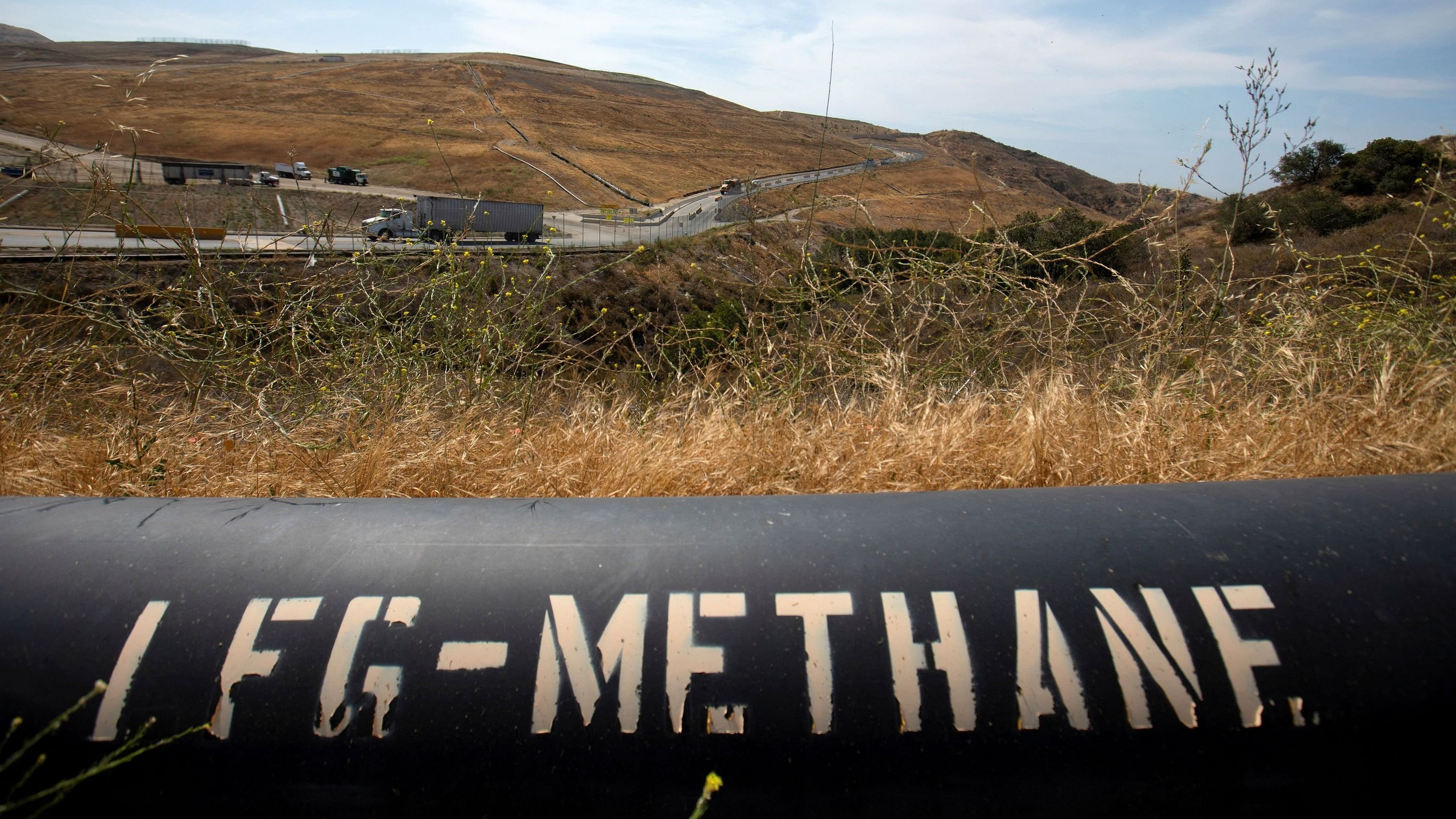
A pipeline that moves methane gas from the Frank R. Bowerman landfill to an onsite power plant is shown in Irvine, California, US.
Credit: Reuters File Photo
By F.D. Flam
Every year, Americans dump over 250 million metric tons of garbage into landfills, where it seems to magically disappear from our lives. In reality, our trash either gets fossilized or digested by vast populations of methane-emitting bacteria.
Over a 20-year horizon, every pound of methane emitted has 80 times the heat-trapping power of the same amount of carbon dioxide. (CO2 lasts much longer in the atmosphere.) And our country’s 1,200 landfills are producing more methane than we realized, according to group of scientists who recently used an aerial remote sensing system to fly over 200 of them.
They measured methane emissions 1.4 times what had been officially recognized by the Environmental Protection Agency. The journal Science published their findings in March.
These revelations underscore that fighting climate change will require reducing or phasing out landfills. That would not only make a huge cut in greenhouse gas emissions, but save tracts of land from getting gobbled up by the growing landfill industry.
The new measurements confirm recent estimates his group has made, said Columbia University professor Nickolas J. Themelis. By his estimate, US landfills emit about 10 million metric tons of methane a year— which over the next 20 years have the greenhouse gas equivalent to 800 million metric tons of CO2. That’s an amount comparable to what’s produced by the aviation industry, he said.
While oil and gas production and agriculture are the biggest sources of methane pollution, landfills place a close third, said the Science study’s lead author, Dan Cusworth, a climate scientist at the University of Arizona and the project scientist for the nonprofit organization Carbon Mapper.
Until recently, the only direct methane measurements scientists could perform on a landfill involved sending some brave soul walking around on top of it, he said. This was far from systematic.
“Landfills are very complex, dynamic environments,” he said. There are hills, and even cliffs. “You can imagine the area where trash is being actively dumped — it’s too dangerous for someone to walk there.” Most prior research on landfill emissions thus relied on mathematical models— which, it turned out, were underestimating the problem. With a technique called airborne imaging spectroscopy, Cusworth's group could better measure emissions from each landfill.
Although Cusworth’s research reveals the true scale of the problem, people have known for decades that landfills create methane, said Sally Brown, a professor at the University of Washington and one of the world’s experts on the secret lives of landfills and their contribution to climate change.
When biodegradable stuff decays above ground or in compost piles, bacteria digest it using oxygen, which produces carbon dioxide. But when your food scraps find themselves under 80 tons of other waste, bacteria resort to a different, oxygen-free (anaerobic) process that produces lots of methane.
In the past, when trash went to an ordinary dump, these emissions could create a fire hazard. Concerns about public safety led the EPA to require that town dumps be replaced by “sanitary landfills” which involve a honeycomb structure of cells lined with clay.
“They had to start collecting gas,” she said, “So that it doesn't go to Joe Schmo’s basement and blow him up when he has a cigar.”
Today, concerns about climate change should spur a similar rethink of landfills. Pipes leading out of the cells could divert some of the methane, Brown said, where it could be used for energy or burned.
Then there’s waste-to-energy plants. While uncontrolled incineration is a major source of air pollution, a well-designed, modern trash-to-energy plant captures of most of the heavy metals, dioxins, particulates and other impurities. In China in 2006, Beijing found itself surrounded by 500 landfills, Columbia’s Themlis said, and since then they’ve started putting most of their garbage into trash-to-energy plants.
The plants do still emit carbon dioxide and some people have protested their construction in their neighborhoods, but Denmark and Japan are already using them to phase out landfills— along with strategies like generating less waste and getting better at recycling.
“You know, I see Elon Musk talking about spending money to populate Mars,” Themelis said. “It’s so absurd … when at the same time, every year, we’re transforming a large patch of green Earth to landfills.”
There are also small things each of us can do to reduce the problem. Most of the methane from landfills comes from food waste, Brown said, and in the US, much of that is made up of edible food. By some estimates, as much as 30 per cent of the food we produce goes into landfills rather than to our tables.
That’s easy to remedy— already, Seattle has cut way down on food waste with better public awareness and systems for getting still-edible food to food banks. Brown said Alameda County, California has another good system for keeping food waste out of landfills.
Another way to get rid of food waste is to turn it into animal feed. Over our Zoom link, Brown showed me a gadget she has in her home that dries out food waste and turns it into chicken feed. “We give it to our neighbor,” she said. In return, the neighbor shares the eggs. Near Las Vegas, there’s a program that diverts food waste to feed pigs.
For whatever waste is left, we’ll have to make smart decisions. Trash-to-energy plants aren’t perfect, but likely have less climate impact than landfills. After all, garbage doesn’t just vanish.